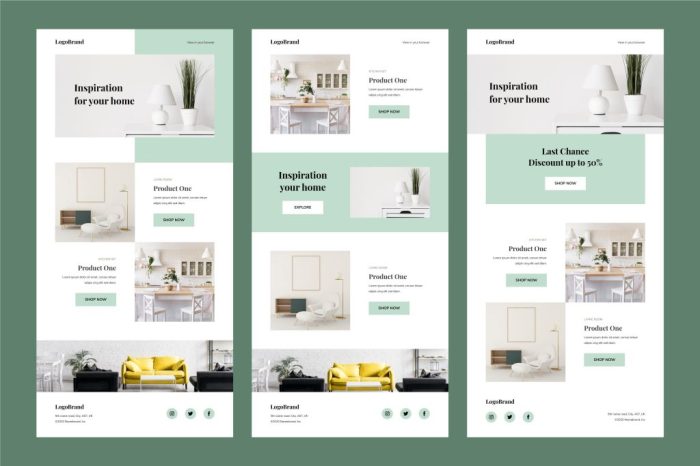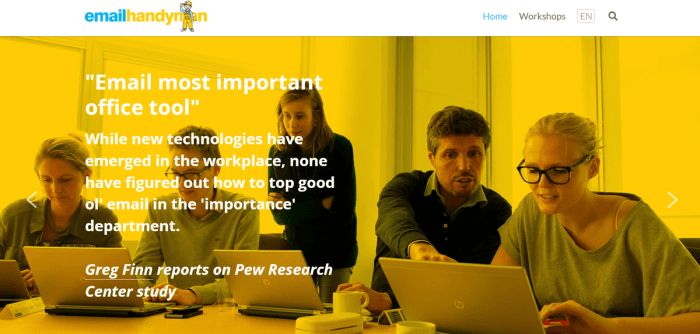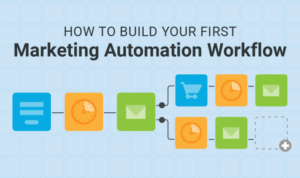Crafting Email Newsletters takes center stage, inviting readers into a world of marketing mastery. Get ready to dive into the art of captivating your audience with every click.
Email newsletters are more than just messages in a digital inbox; they are powerful tools that can build connections and drive engagement. In this guide, we’ll explore the key elements of creating effective email newsletters that resonate with your audience.
Importance of Email Newsletters: Crafting Email Newsletters

Email newsletters are a crucial marketing tool for businesses of all sizes. They provide a direct line of communication with customers and prospects, allowing companies to share updates, promotions, and valuable content.
Engaging with the Audience, Crafting Email Newsletters
One of the key benefits of email newsletters is their ability to engage with the audience on a personal level. By delivering tailored content based on subscriber preferences, businesses can build stronger relationships and increase brand loyalty. Additionally, email newsletters allow for two-way communication, enabling recipients to provide feedback and interact with the brand.
Successful Examples
Many well-known brands have successfully leveraged email newsletters to drive engagement and sales. For example, clothing retailer Nordstrom sends out regular newsletters featuring the latest fashion trends and exclusive promotions, keeping subscribers informed and interested in their products. Similarly, tech giant Apple uses email newsletters to showcase new product releases and updates, creating excitement among their customer base.
Crafting Compelling Subject Lines
When it comes to email newsletters, the subject line is like the cover of a book – it’s the first thing your audience sees, and it can make or break whether they choose to open your email. Crafting a compelling subject line is crucial in grabbing the attention of your subscribers and increasing your open rates.
Importance of Subject Lines
- Subject lines are the first impression: They determine whether your email gets opened or sent straight to the trash.
- They set the tone: A well-crafted subject line can convey the value and relevance of your email content.
- Subject lines impact open rates: Studies show that personalized and engaging subject lines lead to higher open rates.
Tips for Creating Attention-Grabbing Subject Lines
- Keep it concise: Aim for around 40-50 characters to ensure your subject line doesn’t get cut off on mobile devices.
- Personalize it: Use the recipient’s name or other personalized elements to make the email feel more relevant.
- Create a sense of urgency: Use words like “limited time offer” or “act now” to encourage immediate action.
- Ask a question: Pose a question that piques curiosity and entices the reader to open the email for the answer.
Different Approaches to Crafting Subject Lines for Better Open Rates
- Emojis: Adding emojis can make your subject line visually appealing and help it stand out in a crowded inbox.
- A/B testing: Experiment with different subject lines to see which ones resonate best with your audience.
- Action-oriented language: Use verbs that prompt the reader to take action, such as “discover,” “explore,” or “learn.”
- Personalization: Tailor your subject lines to specific segments of your audience to increase relevance and engagement.
Design and Layout
In the world of email newsletters, design and layout play a crucial role in capturing the reader’s attention and conveying information effectively. A visually appealing design can make a newsletter stand out in a crowded inbox and increase engagement with the content.
Importance of Visually Appealing Design
Creating an eye-catching design for your email newsletter is essential to make a strong first impression on your subscribers. A well-designed newsletter not only looks professional but also enhances the overall reading experience. It helps in highlighting important information, guiding the reader’s eye through the content, and reinforcing brand identity.
- Use a clean and organized layout to make the content easy to read and navigate.
- Incorporate images, graphics, and colors that align with your brand and appeal to your target audience.
- Balance text and visuals to maintain a harmonious design that keeps the reader engaged.
- Consider the use of white space to give breathing room to your content and prevent visual clutter.
Best Practices for Designing Email Newsletters
When designing email newsletters, it’s important to follow certain best practices to ensure that your content is visually appealing and effectively conveys your message.
- Optimize for mobile devices: Create a responsive layout that adapts to different screen sizes for better compatibility across devices.
- Stick to a consistent color scheme and typography to maintain brand identity and readability.
- Include a clear call-to-action (CTA) button that stands out and prompts readers to take desired actions.
- Avoid overcrowding the newsletter with too much information; keep it concise and focused on key messages.
Creating a Responsive Layout
To ensure that your email newsletter looks great on any device, you need to create a responsive layout that adjusts to different screen sizes. This involves using fluid grids, flexible images, and media queries to adapt the design based on the device’s screen width.
By designing a responsive layout, you can provide a seamless reading experience for your subscribers, regardless of whether they are viewing the newsletter on a desktop, tablet, or smartphone.
Content Creation

Crafting engaging content for email newsletters is crucial to keeping your audience interested and coming back for more. From informative articles to entertaining stories, there are various types of content that are suitable for newsletters. It’s important to strike a balance between promotional content and valuable information to ensure that your subscribers remain engaged.
Types of Content for Email Newsletters
- Informative Articles: Provide valuable insights, tips, and tricks related to your industry or niche.
- Case Studies: Showcase real-life examples of how your products or services have benefited customers.
- Customer Stories: Share testimonials and success stories from satisfied customers.
- Exclusive Offers: Provide special discounts, promotions, or deals to reward your subscribers.
- Behind-the-Scenes Content: Give a glimpse into your company culture, events, or processes.
Engaging Content Ideas for Newsletters
- Top 10 Lists: Create a list of top products, tips, or trends that would interest your audience.
- Interactive Quizzes: Engage subscribers with fun quizzes related to your industry or products.
- How-To Guides: Offer step-by-step guides on using your products or achieving specific goals.
- Video Content: Share engaging videos that entertain or educate your audience.
- Interviews: Conduct interviews with industry experts, influencers, or customers.
Balancing Promotional and Valuable Content
Maintaining a balance between promotional and valuable content is essential to keep your subscribers engaged. While it’s important to promote your products or services, it’s equally important to provide valuable information that educates or entertains your audience. One way to achieve this balance is by following the 80/20 rule, where 80% of your content is valuable and informative, while only 20% is promotional. This ensures that your subscribers see the value in opening and reading your newsletters, rather than feeling like they are constantly being sold to.





